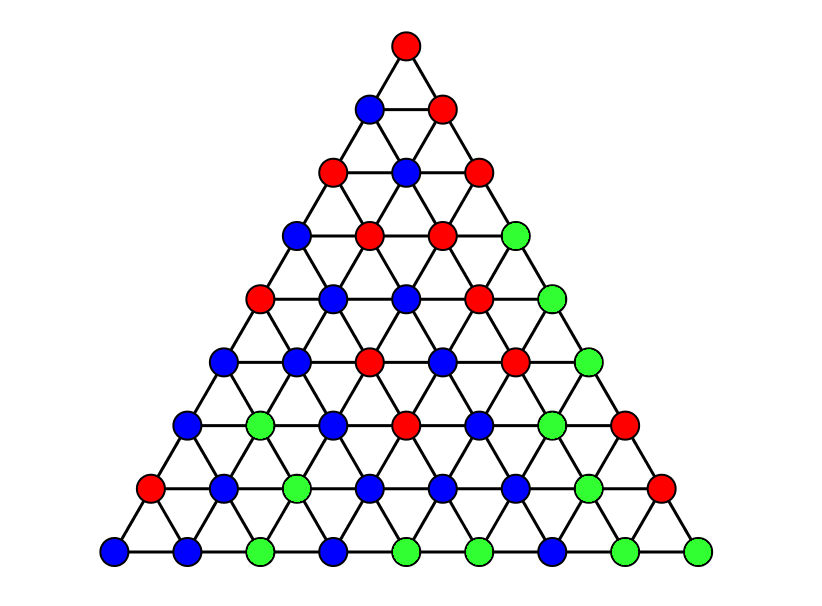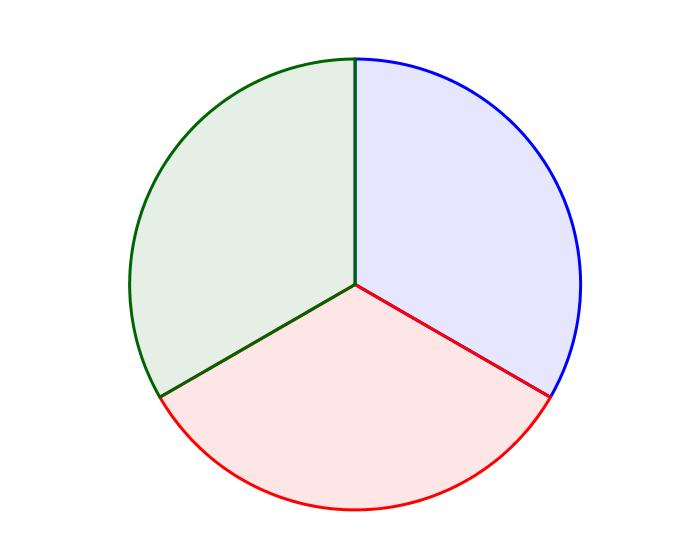This is one of three sets of fixed point exercises. The first post in this sequence is here, giving context.
1. (1-D Sperner's lemma) Consider a path built out of edges as shown. Color each vertex blue or green such that the leftmost vertex is blue and the rightmost vertex is green. Show that an odd number of the edges will be bichromatic.

2. (Intermediate value theorem) The Bolzano-Weierstrass theorem states that any bounded sequence in has a convergent subsequence. The intermediate value theorem states that if you have a continuous function such that and , then there exists an such that . Prove the intermediate value theorem. It may be helpful later on if your proof uses 1-D Sperner's lemma and the Bolzano-Weierstrass theorem
3. (1-D Brouwer fixed point theorem) Show that any continuous function has a fixed point (i.e. a point with ). Why is this not true for the open interval ?
4. (2-D Sperner's lemma) Consider a triangle built out of smaller triangles as shown. Color each vertex red, blue, or green, such that none of the vertices on the large bottom edge are red, none of the vertices on the large left edge are green, and none of the vertices on the large right edge are blue. Show that an odd number of the small triangles will be trichromatic.

5. Color the all the points in the disk as shown. Let be a continuous function from a closed triangle to the disk, such that the bottom edge is sent to non-red points, the left edge is sent to non-green points, and the right edge is sent to non-blue points. Show that sends some point in the triangle to the center.

6. Show that any continuous function from closed triangle to itself has a fixed point.
7. (2-D Brouwer fixed point theorem) Show that any continuous function from a compact convex subset of to itself has a fixed point. (You may use the fact that given any closed convex subset of , the function from to which projects each point to the nearest point in is well defined and continuous.)
8. Reflect on how non-constructive all of the above fixed-point findings are. Find a parameterized class of functions where for each , , and the function is continuous, but there is no continuous way to pick out a single fixed point from each function (i.e. no continuous function such that is a fixed point of for all ).
9. (Sperner's lemma) Generalize exercises 1 and 4 to an arbitrary dimension simplex.
10. (Brouwer fixed point theorem) Show that any continuous function from a compact convex subset of to itself has a fixed point.
11. Given two nonempty compact subsets , the Hausdorff distance between them is the supremum
over all points in either subset of the distance from that point to the other subset. We call a set valued function a continuous Hausdorff limit if there is a sequence of continuous functions from to whose graphs, , converge to the graph of , , in Hausdorff distance. Show that every continuous Hausdorff limit from a compact convex subset of to itself has a fixed point (a point such that ).
12. Let and be nonempty compact convex subsets of . We say that a set valued function, is a Kakutani function if the graph of , , is closed, and is convex and nonempty for all . For example, we could take and to be the interval , and we could have send each to , map to the whole interval , and map to . Show that every Kakutani function is a continuous Hausdorff limit. (Hint: Start with the case where is a unit cube. Construct by breaking into small cubes of side length . Constuct a smaller cube of side length within each cube. Send each small to the convex hull of the images of all points in the cube with a continuous function, and glue these together with straight lines. Make sure you don't accidentally get extra limit points.)
13. (Kakutani fixed point theorem) Show that every Kakutani function from a compact convex subset of to itself has a fixed point.
Please use the spoilers feature - the symbol '>' followed by '!' followed by space -in your comments to hide all solutions, partial solutions, and other discussions of the math. The comments will be moderated strictly to hide spoilers!
I recommend putting all the object level points in spoilers and leaving metadata outside of the spoilers, like so: "I think I've solved problem #5, here's my solution <spoilers>" or "I'd like help with problem #3, here's what I understand <spoilers>" so that people can choose what to read.
Ex 1
Let V={v0,...,vn} and ek:=(vk−1,vk). Given an edge e, let ϕe denote the map that maps the color of the left to that of the right node. Given a k∈{1,...,n}, let ϕk=ϕek∘...∘ϕe1. Let b denote the color blue and g the color green. Let c(k) be 1 if edge ek is bichromatic, and 0 otherwise. Then we need to show that ϕn(b)=g⟹(∑nk=1c(k)) is odd. We'll show (∑nk=1c(k)) is even⟺ϕn(b)=b, which is a striclty stronger statement than the contrapositive.
For n=1, the LHS is equivalent to c(ϕ1)=1, and indeed ϕ(e1)(b) equals g if e1 is bichromatic, and b otherwise. Now let n>1 and let it be true for n−1. Suppose ∑nk=1c(k) is even. Then, if c(en)=1, that means (∑n−1k=1c(k)) is odd, so that ϕn(b)=ϕen(ϕn−1(b))=ϕen(g)=b, and if c(en)=0, then (∑n−1k=1c(k)) is even, so that ϕn(b)=ϕen(ϕn−1(b))=ϕen(b)=b. Now suppose ∑nk=1c(k) is odd. If c(en)=1, then (∑n−1k=1c(k)) is even, so that ϕn(b)=ϕen(ϕn−1(b))=ϕen(b)=g, and if c(en)=0, then (∑n−1k=1c(k)) is odd, so that ϕn(b)=ϕen(ϕn−1(b))=ϕen(g)=g. This proves the lemma by induction.
Ex 2
Ordinarily I'd proof by contradiction, using sequences, that inf{x∈[0,1]|f(x)>0} can neither be greater nor smaller than 0. I didn't manage a short way to do it using the two lemmas, but here's a long way.
Set x0=0. Given n∈N+, let Gn be a path graph of n+1 vertices {vn,0,...,vn,n}, where vn,k=kn. If for any n and k we have f(vn,k)=0, then we're done, so assume we don't. Define c(v,v′) to be 1 if f(v) and f(v′) have s different sign, and 0 otherwise. Sperner's Lemma says that the number of edges e with c(e)=1 are odd; in particular, there's at least one. Let the first one be denoted (v,w), then set xn=max{v,xn−1}.
Now consider the sequence (xn)n∈N. It's bounded because xk∈[0,1]. Using the Bolzano-Weierstrass theorem, let (x′n)n∈N↦x∗ be a convergent subsequence. Since f(xk)>0 for all k∈N+, we have f(x∗)≥0. On the other hand, if f(x∗)>0, then, using continuity of f, we find a number x′>x∗ such that f(x∗,x′)>0. Choose n and k such that vn,k∈(x∗,x′), then c(vn,j)=0 for all j<k, so that xn≥vn,k>x∗ and then xℓ≥xn for all ℓ≥k, so that x∗≥xn≥vn,k>x∗, a contradiction.
Ex 3
Given such a function f, let g:[0,1]↦[−1,1] be defined by g(x)=f(x)−x. We have g(0)=f(0)−0≥0≥f(1)−1=g(1). If either inequality isn't strict, we're done. Otherwise, g(0)>0>g(1). Taking for granted that the intermediate value theorem generalizes to this case, find a root x∗ of g, then f(x∗)=f(x∗)−x∗+x∗=g(x∗)+x∗=x∗.
(v,w) is defined just for one particular graph. It's the first edge in that graph such that f(v)<0<f(w). (So it could have been called (vn,wn)). Then for the next graph, it's a different v. Basically, x1 looks at where the first graph skips over the zero mark, then picks the last vertex before that point, then x2 looks at the next larger graph, and if that graph skips later, it updates to the last vertex before that point in that graph, etc. I think the reason I didn't add indices to (v,w) was just that there ar ealready the v with... (read more)